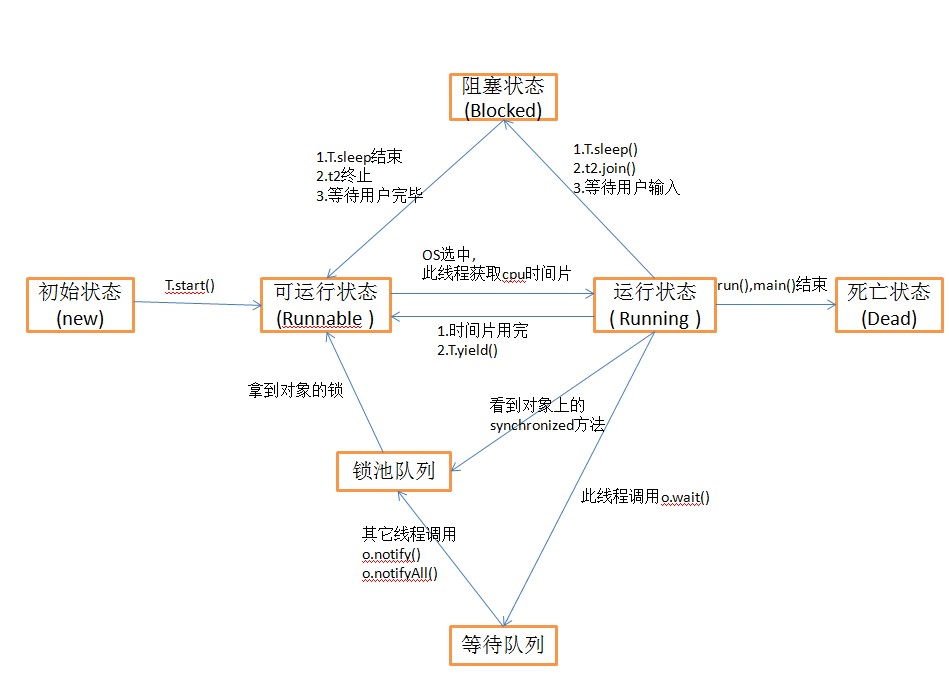线程状态有新生状态,就绪状态,运行状态,阻塞状态,死亡状态
1. 新建(NEW):新创建了一个线程对象。
2. 可运行(RUNNABLE):线程对象创建后,其他线程(比如main线程)调用了该对象的start()方法。该状态的线程位于可运行线程池中,等待被线程调度选中,获取cpu 的使用权 。
3. 运行(RUNNING):可运行状态(runnable)的线程获得了cpu 时间片(timeslice) ,执行程序代码。
4. 阻塞(BLOCKED):阻塞状态是指线程因为某种原因放弃了cpu 使用权,也即让出了cpu timeslice,暂时停止运行。直到线程进入可运行(runnable)状态,才有机会再次获得cpu timeslice 转到运行(running)状态。阻塞的情况分三种:
(一). 等待阻塞:运行(running)的线程执行o.wait()方法,JVM会把该线程放入等待队列(waitting queue)中。
(二). 同步阻塞:运行(running)的线程在获取对象的同步锁时,若该同步锁被别的线程占用,则JVM会把该线程放入锁池(lock pool)中。
(三). 其他阻塞:运行(running)的线程执行Thread.sleep(long ms)或t.join()方法,或者发出了I/O请求时,JVM会把该线程置为阻塞状态。当sleep()状态超时、join()等待线程终止或者超时、或者I/O处理完毕时,线程重新转入可运行(runnable)状态。
5. 死亡(DEAD):线程run()、main() 方法执行结束,或者因异常退出了run()方法,则该线程结束生命周期。死亡的线程不可再次复生。

下面对几种线程状态的实现举例说明:
* 终止线程
* 1,线程正常执行完毕
* 2,加入标志位
1 package cn.ftf.thread; 2 /** 3 * 终止线程 4 * 1,线程正常执行完毕 5 * 2,加入标志位 6 * 7 * @author 房廷飞 8 * 9 */ 10 public class TerminateThread implements Runnable{ 11 12 public TerminateThread(String name) { //给线程起个名字方便查看 13 super(); 14 this.name = name; 15 } 16 //加入标志位 17 private boolean flag=true; 18 private String name; 19 20 @Override 21 public void run() { 22 int i=0; 23 //在run()里关联标志位 24 while(flag) { 25 System.out.println(name+"-->"+i++); 26 } 27 28 } 29 30 //对外提供方法改变状态 31 public void stopThread() { 32 flag=false; 33 } 34 35 36 public static void main(String[] args) { 37 TerminateThread tt=new TerminateThread("线程"); 38 Thread th=new Thread(tt); //线程新生状态 39 th.start(); //线程就绪状态 40 41 for(int i=0;i<100;i++) { 42 //当遍历到88时,改变标志位为flase 43 if(i==88) { 44 tt.stopThread(); //控制了线程的终止 45 System.out.println("tt.终止了!"); 46 } 47 System.out.println("遍历--》"+i); 48 } 49 } 50 }
Thread.sleep() 线程阻塞,常用于延时
1 package cn.ftf.thread; 2 /** 3 * sleep()模拟发生网络延迟,有了延迟就放大了发生问题的可能 4 * @author 房廷飞 5 * 6 */ 7 8 9 public class BlockedSleep { 10 public static void main(String[] args) { 11 new Thread(new Web12306()).start(); 12 new Thread(new Web12306()).start(); 13 new Thread(new Web12306()).start(); 14 } 15 } 16 17 class Web12306 implements Runnable{ 18 static int ticketNums=10; 19 20 @Override 21 public void run() { 22 while(true) { 23 if(ticketNums<0) { 24 break; 25 } 26 27 //模拟延时 28 try { 29 Thread.sleep(200); 30 } catch (InterruptedException e) { 31 // TODO Auto-generated catch block 32 e.printStackTrace(); 33 } 34 System.out.println(ticketNums--); 35 } 36 37 } 38 39 }
.join()线程阻塞,插队线程,.join()的线程先执行完
1 package cn.ftf.thread; 2 /** 3 * join插队线程,合并线程,等.join()的线程走完才能继续进行其他线程,.join需要实例化对象才能调用 4 * @author 房廷飞 5 * 6 */ 7 public class BlockedJoinTest { 8 9 public static void main(String[] args) throws InterruptedException { 10 Thread th=new Thread(()-> { 11 for(int i=0;i<100;i++) { 12 System.out.println("A "+i); 13 } 14 15 }); 16 th.start(); 17 for(int i=0;i<100;i++) { 18 System.out.println("B "+i); 19 if(i==50) { 20 //Thread.sleep(20000); 21 th.join(); //线程th插队,等th线程走完才能继续进行其他(main)线程 22 } 23 } 24 } 25 }
Thread.yield() 回到就绪状态
1 package cn.ftf.thread; 2 /** 3 * yield礼让线程不阻塞,直接进入就绪状态,公平竞争 4 * @author user 5 * 6 */ 7 public class YieldTest { 8 public static void main(String[] args) { 9 MyYield my=new MyYield(); 10 new Thread(my,"A进程").start(); 11 new Thread(my,"B进程").start(); 12 new Thread(my,"C进程").start(); 13 } 14 15 } 16 17 class MyYield implements Runnable { 18 19 @Override 20 public void run() { 21 System.out.println(Thread.currentThread().getName()+"开始"); 22 23 Thread.yield(); //礼让一下,返回就绪状态 24 25 System.out.println(Thread.currentThread().getName()+"结束"); 26 27 } 28 29 }
线程状态:
1 package cn.ftf.thread; 2 3 import java.lang.Thread.State; 4 5 public class AllState { 6 public static void main(String[] args) throws InterruptedException { 7 Thread th=new Thread(()->{ 8 for(int i=0;i<5;i++) { 9 try { 10 Thread.sleep(200); 11 } catch (InterruptedException e) { 12 // TODO Auto-generated catch block 13 e.printStackTrace(); 14 } 15 System.out.println("hahahaha..."); 16 } 17 }) ; 18 //观察状态 19 State state=th.getState(); 20 System.out.println(state.toString()); 21 th.start(); 22 state=th.getState(); 23 System.out.println(state.toString()); 24 Thread.sleep(100); 25 state=th.getState(); 26 System.out.println(state.toString()); 27 Thread.sleep(1000); 28 state=th.getState(); 29 System.out.println(state.toString()); 30 31 } 32 } 33 34 /* 35 NEW 36 RUNNABLE 37 TIMED_WAITING 38 hahahaha... 39 hahahaha... 40 hahahaha... 41 hahahaha... 42 hahahaha... 43 TERMINATED 44 */
线程的优先级:
1 package cn.ftf.thread; 2 /** 3 * 优先级 4 * @author 房廷飞 5 * 6 */ 7 public class PriorityTest { 8 public static void main(String[] args) { 9 System.out.println(Thread.currentThread().getPriority()); //获得当前线程的优先级 10 11 Thread th=new Thread(new Test01(),"零"); 12 Thread th1=new Thread(new Test01(),"一"); 13 Thread th2=new Thread(new Test01(),"二"); 14 Thread th3=new Thread(new Test01(),"三"); 15 Thread th4=new Thread(new Test01(),"四"); 16 Thread th5=new Thread(new Test01(),"五"); 17 18 //在启动前设置优先级,优先级:1~10 19 th.setDaemon(true); 20 21 th.setPriority(Thread.MAX_PRIORITY); //获得最大优先级 22 th1.setPriority(Thread.MAX_PRIORITY); 23 th2.setPriority(10); //可以自己设置 24 th3.setPriority(Thread.MIN_PRIORITY); 25 th4.setPriority(Thread.MIN_PRIORITY); 26 th5.setPriority(1); 27 28 29 th.start(); 30 th1.start(); 31 th2.start(); 32 th3.start(); 33 th4.start(); 34 th5.start(); 35 36 37 } 38 39 } 40 41 class Test01 implements Runnable{ 42 43 @Override 44 public void run() { 45 System.out.println("线程。。。"+Thread.currentThread().getName()); 46 } 47 } 48 /* 49 * 运行结果 50 51 5 52 线程。。。零 53 线程。。。二 54 线程。。。一 55 线程。。。五 56 线程。。。三 57 线程。。。四 58 */ 59 /* 60 设置守护线程: 61 JVM不会随守护线程的停止而停止,只关心用户线程 62 th.setDaemon(true); 63 64 */